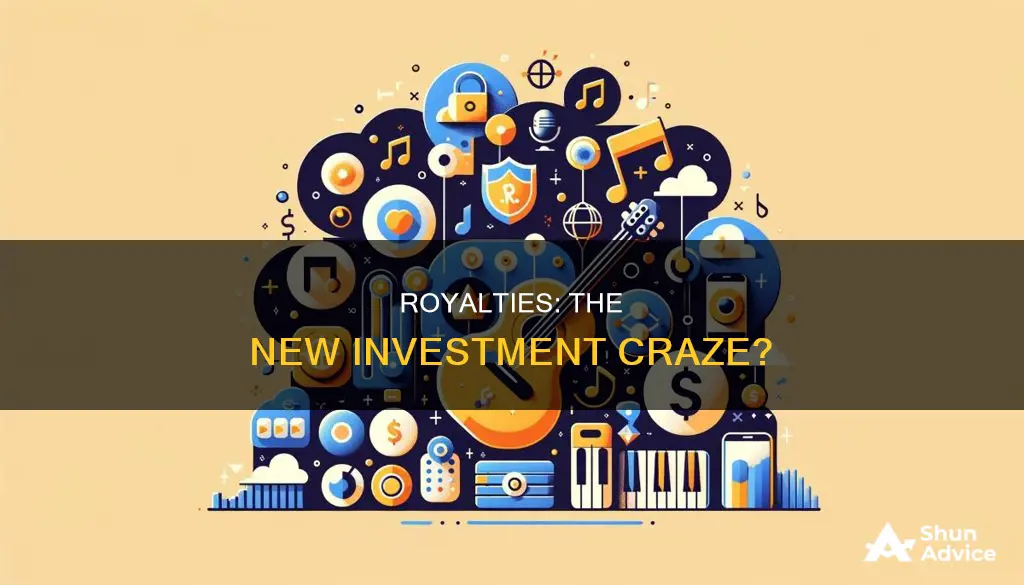
Investing in royalties is a popular alternative investment strategy that can provide a steady income stream and diversify an investment portfolio beyond stocks and fixed-income securities. Royalties are payments received for the use of intellectual property, such as music, literature, patents, trademarks, and copyrighted works. They are considered less risky than traditional stocks as they are not correlated with the stock market or interest rates and often provide long-term revenue streams. Investors can purchase royalties directly through online exchanges or by buying shares of royalty trusts, which provide access to royalty streams. This allows investors to earn money while they sleep, with strong earning potential and lower tax rates compared to wages and salaries.
| Characteristics | Values |
|---|---|
| Why do people buy royalties as investments? | To generate a recurring cash flow, obtain higher-yield investments, and diversify their portfolio |
| Type of investment | Alternative investment |
| Type of income | Passive income |
| Performance | Independent of public markets and stock or bonds |
| Returns | Long-term |
| Risk | Low correlation with traditional markets |
| Examples of royalties | Music, art, entertainment, natural resources, and businesses |
What You'll Learn

Music royalties
Music royalty income is a source of recurring income. It is paid periodically to music IP rights holders by several different distributors. This recurring payment structure is desirable for investors seeking predictable income, similar to that found in asset classes such as real estate.
Another benefit of investing in music royalties is the potential for diversification. Music royalties have a low correlation with other asset classes, meaning their value does not necessarily move in tandem with the stock market or other traditional investments. This can provide stability and protection during volatile market periods.
Investing in music royalties also allows investors to participate in the music industry without requiring specialized knowledge or expertise. This accessibility, combined with the potential for attractive financial returns, makes music royalties an appealing investment opportunity.
There are several ways to purchase music royalties, including direct purchases from artists, royalty exchange platforms, and specialist websites. When evaluating music royalties as an investment, it is crucial to assess the value by considering factors such as the artist's popularity, the stability of the music industry, and the potential for future earnings growth.
In conclusion, investing in music royalties offers financial advantages, diversification benefits, and the opportunity to participate in the thriving music industry. With careful research and evaluation, investing in music royalties can be a rewarding strategy for investors seeking alternative investment opportunities.
Small Investments, Big Returns
You may want to see also

Performance royalties
When investing in performance royalties, it is important to conduct thorough research and due diligence. Investors should assess the musician's reputation, popularity, and customer base to determine the long-term potential for revenue generation. Additionally, it is crucial to understand the risks associated with any investment, including valuation risk, counterparty risk, and the potential impact of external factors such as inflation and regulatory changes.
Theranos Investors: Medical Backgrounds?
You may want to see also

Mechanical royalties
Each musical work has two copyrights attached to it: composition and recording. Mechanical royalties are paid to the owner of the composition copyright. When an artist or record company releases a musical composition through their unique performance and sound recording, a mechanical license requiring payment of a mechanical royalty is owed to the music publisher and songwriter.
In the United States, the Harry Fox Agency is the leading mechanical rights organization, handling licensing, collection, and distribution of mechanical royalties. The Music Modernization Act of 2018 helped update various aspects of the music publishing sector, including mechanical royalty rates for streaming services.
Apple Investors: Who's Involved?
You may want to see also

Print music royalties
When investing in print music royalties, it is important to consider the popularity and demand for the song, as this can impact the earnings from royalty payments. Additionally, there may be risks associated with investing in music royalties, such as changing consumer preferences, technological advancements, and legal issues.
Investing in print music royalties can provide a unique opportunity for investors to diversify their portfolios and generate a passive income stream. By purchasing these royalties, investors are essentially buying a share of the future earnings generated by a song. As the popularity of the song increases, so does the value of the royalties, potentially resulting in significant financial gains.
Overall, print music royalties offer a way for investors to tap into the music industry and participate in its success, providing both financial and non-financial benefits.
Stash Investing: Millions of Users
You may want to see also

Oil and gas royalties
There are two types of investors in oil and gas royalties: interest owners and non-interest owners. Interest owners are investors who also own the property or the company that is prospecting, drilling, or extracting materials from the ground. Non-interest owners, on the other hand, are investors who are not responsible for these activities and only have an interest in the output of the well, not the costs involved in discovery, accessing, or production.
When investing in oil and gas royalties, it is important to understand the different types of royalty interests, which include working interest, royalty interest, non-participating royalty interest, and overriding royalty interest. Working interest involves exploration, drilling, and production activities, and the owner incurs all the associated costs. Royalty interest, in contrast, does not require the owner to bear any operational costs, making it a more favourable option for smaller companies. Non-participating royalty interest includes a share in royalties from production revenues but no rights to issue new leases or receive bonuses or lease payments. Overriding royalty interest occurs when a working interest owner leases a part of their interest to a third party.
There are several benefits to investing in oil and gas royalties. Firstly, they can provide a steady and stable income stream, generating annual returns that are often higher than those available in the traditional real estate market. Secondly, royalty owners do not invest in capital equipment or field operations and are not billed for exploration, drilling, or operating wells. They also do not share in the risks, liabilities, or costs associated with these activities. Oil and gas royalties can also provide portfolio diversification and tax savings, as royalty income is considered passive income and is generally taxed at lower capital gains tax rates.
However, there are also risks to consider when investing in oil and gas royalties. The biggest risk is pricing and production variability, which can cause fluctuations in a royalty owner's monthly income. Additionally, it is important to exercise caution when buying privately sold royalty rights to determine actual ownership, land and production values, deed and title concerns, and other important considerations. Working with a reputable and experienced brokerage can help mitigate these risks and provide valuable insights and expertise.
Young Investors: Who and How Many?
You may want to see also
Frequently asked questions
Royalties are payments made to creators or rights holders for the use of their physical or intellectual property, such as music, literature, or patents.
Investing in royalties offers a unique chance for passive income, often with minimal correlation to traditional markets and potential for long-term returns.
Like all investments, royalties carry some degree of risk. There's valuation risk, the threat of counterparty risk, and the potential for overpayment.
You can buy royalties through an online exchange or marketplace such as Royalty Exchange or SongVest.
There are several types of royalties that you can invest in, including copyrighted works, natural resources, and businesses.







